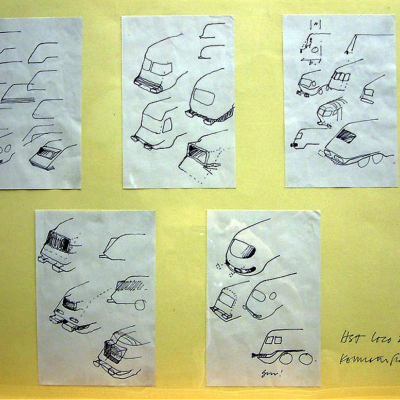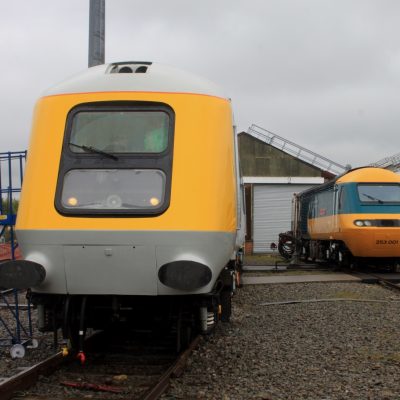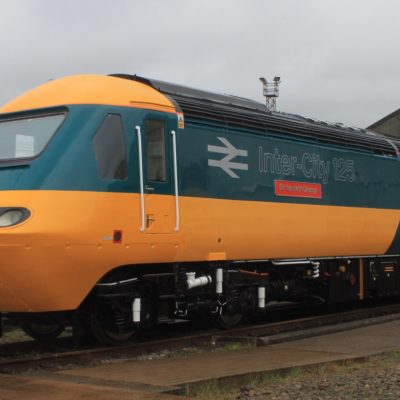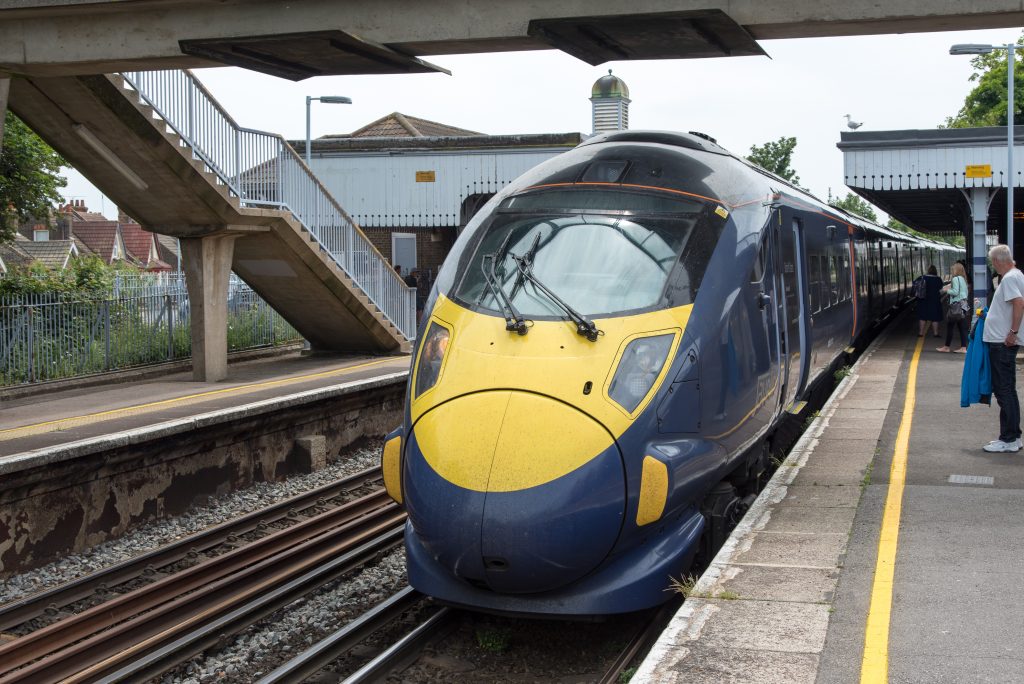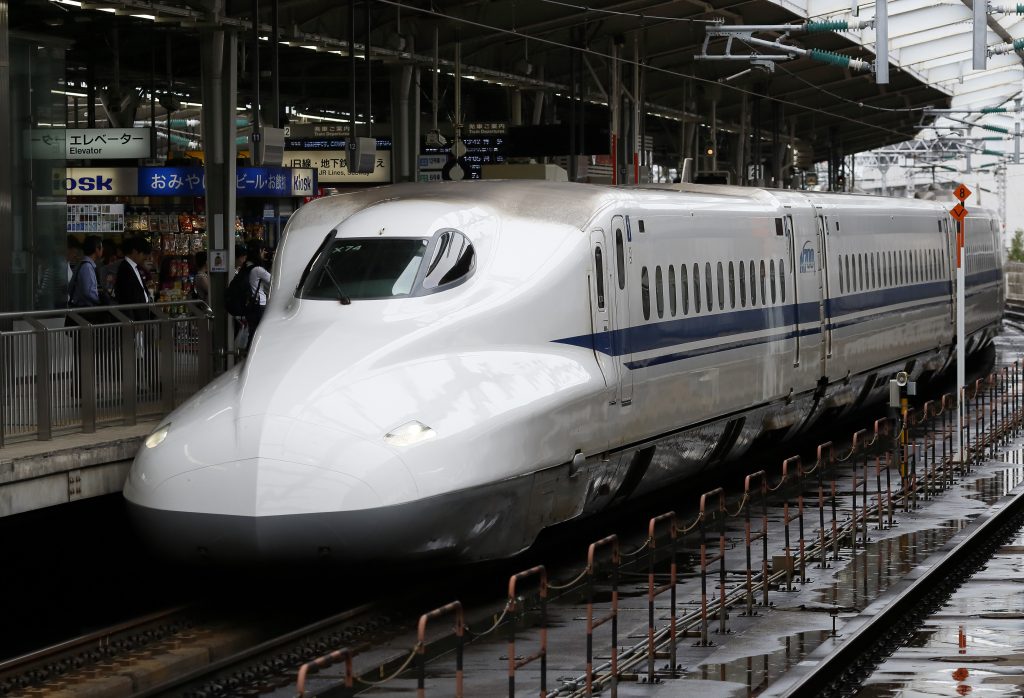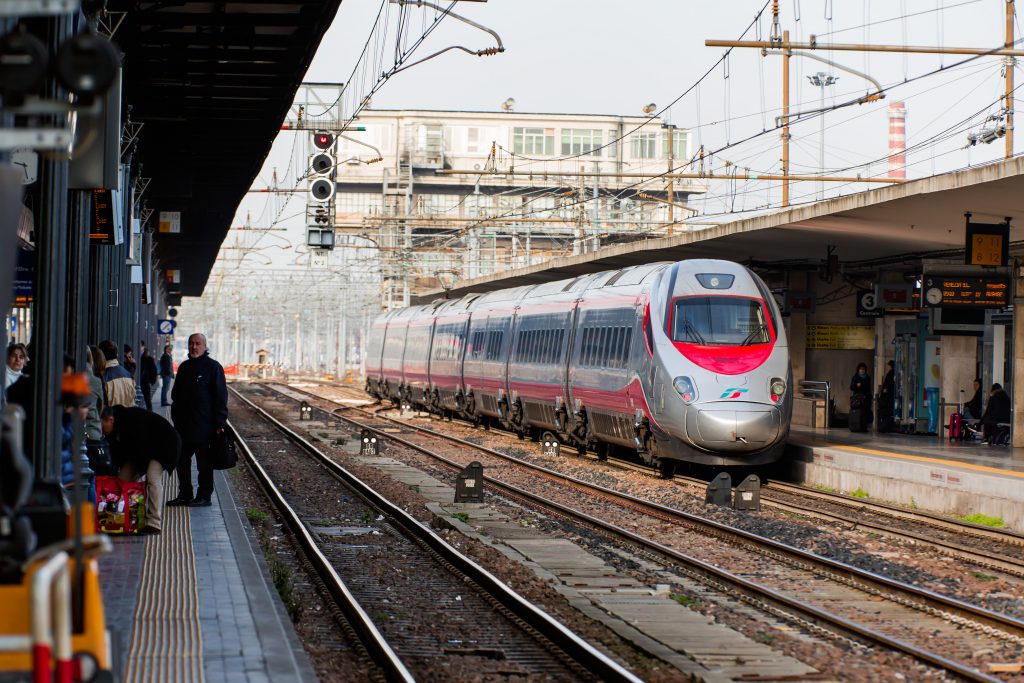The Institution of Mechanical Engineers frequently organises topical seminars with excellent speakers. This one was no exception with speakers such as Jim Steer and Andrew McNaughton. The timing of the event was to celebrate the success of the UK’s High Speed Train (HST), which has been responsible for transforming the image of inter-city rail travel since it entered service on 4 October 1976. It was the 08:05 London Paddington to Bristol Temple Meads, although one member of the audience was on what he was told was the first train which departed from Weston Super Mare. Perhaps there was a first “up” and a first “down” train?
As Andrew Mellors, deputy managing director and engineering director of GWR said, as he introduced the event, the purpose was not to rake over the history of the HST, more to nod to its history whilst looking forward at the technologies that are required for today’s and tomorrow’s high speed lines.
Yesterday
The first presentation was by another Andrew – Andrew McLean, the head curator at the National Rail Museum in York. His title of “The Most Successful Train in the World?” referred to the impact of the HST. His assertion was that the UK has always been in the forefront of high-speed railways ever since Stephenson’s Rocket travelled at the unheard of speed of 30mph, and that the times when the UK appeared to be in the speed wilderness were mere blips of history.
Andrew treated the audience to a gallop through railway development in the nineteenth century before going on to the era between the two World Wars, immediately following the formation of the “big four” railway companies. He focussed particularly on the London and North Eastern Railway and its chief mechanical engineer (later Sir) Nigel Gresley, who pushed the envelope to and beyond 100mph.
Gresley was a man who travelled widely and had befriended Ettore Bugatti, from whom he learned the importance of streamlining. He applied these ideas to the A4 pacific locomotives, but also to the rest of the train with articulated coaches where the gaps between coaches with ‘India-rubber fairings’, and a streamlined observation car minimised turbulence following the train.
Andrew also emphasised the importance of LNER’s publicity and service that accompanied the streamlined trains, with the train as the very visible and marketable ‘face’ for the offering.
The second World War and nationalisation almost certainly extended the life of steam in the UK by about 20 years, and the story moves to the 1960s where there was both an urgent need to do something about the competitiveness of long distance rail and to solve some fundamental problems of keeping trains on the track at higher speed. Andrew mentioned three people who were transformational in UK railways and had influence worldwide.
Dr Alan Wickens led the research work to understand why high speed trains were prone to derail and to provide solutions, leading directly to the work on the Advanced Passenger Train.
Terry Miller, then chief mechanical engineer of British Railways, led the development of the HST and the strong, light and spacious Mark 3 carriage; and Kenneth Grange designed the iconic and timeless “face” of the HST. Andrew argued that these three men had a transformational impact on the UK’s long distance passenger services. Together with the Deltics on the East Coast, and the ‘sparks effect’ on the West Coast main lines, BR had products that could be marketed well, and developed the ‘Inter-City’ brand, with the HST and Mark 3 coach featuring strongly in advertising. The HST still holds the world speed record for a diesel train of 148mph, recorded in 1987.
Andrew concluded that the HST has had a transformational impact on the UK economy (for example, people now commute to London from York) and is going to continue in front line inter-city service in Scotland until the end of the 2020s, still retaining the timeless good looks designed by Kenneth Grange all those years ago.
Today and tomorrow
The keynote address was given by Karen Boswell OBE, managing director of Hitachi Rail Europe. Her message was that high speed has been good for Britain. Moving on from the success of the HST, she talked about the contribution of the class 395 trains to the economy of Kent, how these trains have halved the journey time to Ashford and that the domestic high speed service carries half the passengers that use the High Speed 1 route.
The success of this fleet has established Hitachi’s reputation in the UK and has led to the orders for high- speed trains for East Coast, Great Western Railway and Trans Pennine Express as well as inter-regional trains for the Edinburgh-Glasgow route.
Karen’s message emphasised connectivity, creativity, collaboration, and engagement with people at all levels, whether customers or employees. Moreover, she highlighted that high-speed lines are successful the world over. Don’t let critics talk HS2 down, she said.
Practical lessons of high speed
Jim Steer, who set up Steer Davies and Gleave in 1978 and has been a champion of high speed rail for over three decades, talked about what can be learned from 125mph operation in the UK, from High Speed 1 and from the experience of France.
Jim highlighted that, as 125mph operation spread through the UK, journey times fell, stimulating more journeys and land development. Many of these improvements took place at roughly the same time as other developments including motorways, housing and retail. As such, it was not easy to attribute which activity contributed most to the economy. Complicating the picture is the green belt land around most of the UK’s major cities, which means that development might not necessarily be allowed to happen. He cited examples of Doncaster and Newport, which received high speed trains but did not receive significant economic development.
For his section on HS1, and with reference to the fears of many of HS2’s neighbours, Jim recalled that the Eurostar train is comparatively noisy and that it was the subject of many complaints when running over the old boat train route on the Southern electric network. These complaints ceased when HS1 opened. His point is that a well-designed high-speed railway is generally not intrusive on neighbours’ lives. The key points included:
- HS1 has stimulated development around Kings Cross/ St Pancras whilst Ebbsfleet has yet to catch up;
- HS1 was justified on forecast Eurostar numbers that have never been forthcoming although the introduction of the domestic high-speed service has delivered, overall, passenger numbers in line with forecasts;
- Reliability of the HS1 infrastructure is very high;
- Infrastructure needs to be flexible and this flexibility has value for uses not envisaged when the line was built, such as the HS1 domestic service.
France
With its main cities tending to be separated by significant distances, France was an ideal location to grow high-speed rail. For example, the first high-speed line, from Paris to Lyon, currently runs trains in just two hours. By comparison, a car journey takes four hours and, unless you are close to either airport, flying is slower than the train.
The success of the high-speed lines is well known; France is currently constructing four more lines, and the risks and rewards have become well enough understood to make a Public Private Partnership viable. Jim also highlighted that countries which have commenced building high speed lines have always built more of them.
He added though, that a number of lessons have been learned. France expanded TGV services but has recognised that secondary routes have been neglected. Furthermore. the president of SNCF has declared that railways are guilty of underestimating long term growth, that more cross-Paris travel routes should have been provided and that strategic thinking should be applied to linking every major town and city, and not just be Paris- centric.
In closing, Jim Steer made several points. Mixed traffic railways are not efficient users of capacity, and taking long-distance fast journeys off existing lines provides the opportunity to improve the offering on those existing lines.
The HS2 business case assumes best-case growth of about 2.8 per cent, although current actual growth is significantly greater than the HS2 best case.
And the key to the success of high-speed lines is improved connectivity, both for customers and for regional economies.
What Can the UK learn from Japan?
Felix Schmid, director of education at the Centre for Railway Research and Education at Birmingham University, compared the European and Japanese approaches to high-speed rail or, as he asked, “Is it all about speed?”
Starting with a little self-deprecation, Felix told his audience: “I visited Japan thanks to Central Japan Railways’ exchange programme. I had read lots about Japan, about its railways and the Shinkansen and I was convinced that I would learn nothing new! And then I understood…”
Felix highlighted the essential truisms of high-speed rail everywhere – bringing communities closer together – and contrasted some of the engineering approaches in Britain and in Europe with those adopted in Japan. He illustrated how the Shinkasen developed on Honshu island, which is slightly smaller than Britain but has nearly twice the population.
More significantly, the Tokyo – Osaka corridor (about 500km apart) represents less than 25 per cent of Japan’s land mass, but has nearly 60 per cent of the population and more than 60 per cent of Japan’s economic activity. It was between these two cities that the Tokaido Shinkasen opened in 1964, partly to reduce journey times and partly to improve capacity.
The opportunity to increase services on Japan’s conventional 1067mm gauge mixed traffic lines was small. The Japanese decided to create the new line using standard gauge, dedicated solely to the high-speed service, thus not importing any of the issues that might affect the narrow-gauge lines. From opening, the reliability of the service has been legendary, with average delays of less than six seconds per train.
In covering the expansion of the network, Felix superimposed the network onto a light pollution map showing the distribution of Japan’s urban population, and how, in the interests of connectivity, both dense and lightly populated areas are served.
Felix moved onto railway system design, where there are some differences in approach between Europe and Japan. As the Shinkansen has always been a dedicated system, Japan has developed its infrastructure based on the needs of the train. For example, the Japanese engineers determined that a width of almost 3.4 metres was required to accommodate rows of 3+2 seats in standard class. This determined the structure gauge and track spacing.
However, in the desire to build stations in densely populated areas, where people want to go, land take had to be kept to a minimum. It became usual, therefore, to specify quite short turnouts with an operating speed of 75km/h. For these not to be a constraint, trains with high acceleration and braking rates were specified.
Conversely, in Europe, it is quite common for high-speed trains to have their own infrastructure and also to use the existing infrastructure at ends of the line, sometimes for a considerable distance. Thus, the vehicle gauge has to be compatible with the existing lines, which is almost always smaller than in Japan.
In Europe, space is often made available for longer, 230km/h turnouts from the main line to a deceleration track and then 95km/h into platforms, with the reverse for acceleration. These turnouts are rated at more or less the correct speeds for the deceleration (and acceleration) curve of the trains, and thus a stopping train will get out of the way of a following train with minimal impediment. The higher the throughput required, the more important this becomes, particularly if the stopping pattern is irregular.
However, 230km/h turnouts are very long and require considerable track equipment to make them work, resulting in issues for maintenance and reliability.
Felix’s point was that the high-power train and simpler infrastructure provided a number of benefits such as:
- High ratio of motored axles increases acceleration andbraking rates – the latest Japanese trains have all axlesmotored;
- All axles motored opens the way for purely electro-dynamic braking (270km/h to 30km/h);
- Low speed (75km/h) turnouts have multiple benefits:» No need for swing nose crossings / moving frogs;
- Low complexity and cheaper to buy and renew;
- Reduced land take and lower track forces;
- Replacement in one five-hour maintenance window.
- Low technology maintenance is flexible.
Felix also stated that all aspects of a journey need to be considered in the planning of high-speed lines. His example was a three-hour journey where only 90 minutes are on the train. If a high-speed line allows the on-train time to be reduced to 60 minutes, the saving in on-train time is one-third but the saving on the overall journey is only one-sixth.All phases of a journey, both value-adding and non- value-adding, need to be considered. Non-value-adding elements include having to wait 10 minutes to buy a ticket or walking up and down the train to find a seat.
He also illustrated the sort of analysis that can be undertaken to minimise the activities necessary at terminus stations (other than disembarking and embarking passengers). He compared this with what the low cost airlines have done to minimise time on stand at airports.
Developments in high-speed rail
Andrew McNaughton, technical director HS2, has over 40 years in the industry or, as he put it “40 years of mistakes and they call it wisdom”. Andrew’s approach was to emphasise similarities, not differences, because, he said in his understated way, “the laws of physics are pretty much the same worldwide”.
High-speed rail is over 50 years old, has been adopted across the world and has all been built to similar technical standards. Andrew illustrated the point with a photograph taken in Korea of a train to largely French standards on track to largely German standards.
Highlighting some different approaches to optimising requirements that can possibly be conflicting, such as connectivity, capacity, reliability and availability, Andrew described how there are broadly three categories of high- speed lines in different countries/continents.
In Asia, closed systems are preferred, with high-speed trains running solely on dedicated infrastructure. This tends to produce the highest capacity and reliability.
France, Italy, and the UK have generally adopted high- speed infrastructure where only high-speed trains run, but some of those continue on existing ‘classic’ lines to destinations beyond the high-speed network. There is generally high capacity on the high-speed line.
Germany, Austria and Switzerland have built new high- speed lines that allow mixed high speed, conventional and even freight trains to operate to destination on existing lines. These tend to have lower capacity reflecting limited demand.
Andrew talked about the discipline and opportunities offered by closed systems which are similar to those of a metro – managing all aspects of the operation to maximise capacity. The issue of demand is critical, there’s no point building the railway if the demand isn’t there. Moreover, if there is demand for a new railway, then it might as well be build it as a high-speed one – the additional cost is comparatively small and the benefits are significant.
Moving onto HS2, Andrew reiterated that HS2 is all about capacity. Britain is growing. In 2008 the population of England was about 52 million, by 2033 it’s estimated to rise to 60 million and to 70 million by 2050. He illustrated the UK with a light-pollution map and superimposed the path of the Y-shaped HS2 line to illustrate that it is planned for HS2 to go where the people are located.
Andrew outlined the operational specification for the core section:
- Capacity: up to 18 services per hour each way of up to1,100 people per train, which represents roughly the capacity of three 3-lane motorways;
- Availability: operational hours 05:00 to 24:00 (0:800 onSundays);
- Reliability: average delay less than 30 seconds per service;
- Journey times will be based on up to 360km/h maximum speed balanced with environmental impact;
- Reduction of whole journey time – station design,service frequency will both be part of the mix.
He then moved on to infrastructure maintenance specification. Bluntly, he said infrastructure maintenance is still in the dark ages. Anyone running trains at speeds of 100m/s or more (360km/h) really ought to know on a continuous basis that it’s safe to do so and it should rarely, if ever, cause service-affecting delays. His outline maintenance specification is thus:
- Automation of examination/condition monitoring;
- Preventive servicing;
- Mechanisation of maintenance (replace not repair);
- Largely rail-based;
- Standardised elements;
- ‘Factory’ approach throughout.
Building on his comments about the whole journey, Andrew showed a number of cartoons that had been produced when interviewing potential customers on their wants and needs from the stations. The challenge for the designers is to provide for many thousands of individual journeys and all sorts of individual needs, but common factors emerge such as ‘no barriers’ and ‘no steps’.
Andrew foresaw that customers should be able to navigate the station to their train using satnav style spoken instructions though their smart phone, based solely on knowledge of their current location and their train time/seat number. Clearly there are a number of developments required to make all this happen, not least the ticketing system to enable ‘barrierless’ travel.
His team is already modelling the performance of the line as it is being designed using BIM (Building Information Modelling), which allows all elements to be integrated in a virtual world to ensure they all work together before anyone starts building anything.
Metro – a digital incubator for high-speed rail
Andrew Love and Doug Blanc of SNC-Lavalin argued the proposition that the integrated approach of modern metros provides a working model for closed system high- speed systems.
For example, metro CBTC systems do today what it is hoped the ETCS level 3 might do at some point in the future. However each supplier’s CBTC system is proprietary and the trains and infrastructure both have to have the same system.
It is also fair to say that few, if any, metro CBTC systems cope well with freight (engineers’ trains in metro-speak). Metros usually have the advantage of integrated management, ability to specify the whole system and have relatively small fleets/infrastructure compares with most main line railways. However, taking the system design principles and applying them to the HS situation is a valid proposition.
All in all, it was interesting to hear of the various developments, both in the UK and overseas. Whilst there were some differences of opinion, speakers generally agreed on the way forward. The only significant divergence of view was about the proposed station track layout and length of points, with Felix Schmid advocating the Japanese short points whereas HS2 is proposing something that takes up more space but is likely to have headway benefits.
Andrew McNaughton summed it up pretty well when he said, in response to a question, “Well, decisions have to be made”.
Written by Malcolm Dobell

